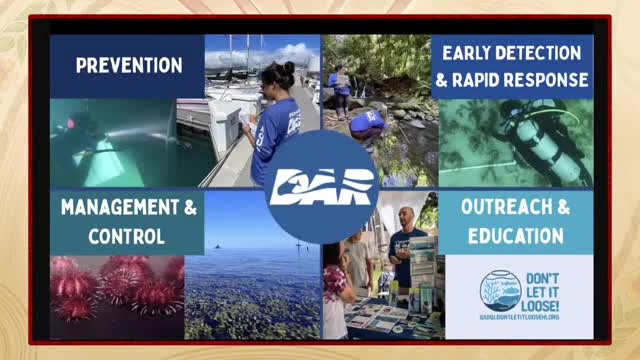Hawaii's Division of Aquatic Resources battles invasive species amid rising environmental threats
January 18, 2025 | House Committee on Agriculture & Food Systems, House of Representatives, Legislative , Hawaii
This article was created by AI summarizing key points discussed. AI makes mistakes, so for full details and context, please refer to the video of the full meeting. Please report any errors so we can fix them. Report an error »

The House Committee on Agriculture & Food Systems convened on January 17, 2025, to discuss critical issues surrounding aquatic invasive species in Hawaii, led by the Division of Aquatic Resources (DAR). The meeting highlighted the agency's ongoing efforts to manage and prevent the introduction of invasive species, which have seen a significant increase in recent years.
DAR reported that the past year was particularly busy for rapid response efforts, with numerous outbreaks of invasive soft corals and anemones. The agency emphasized the importance of preventing new introductions, as ballast water and hull fouling are the primary causes of these invasions. A new federal regulation, the Vessel Incidental Discharge Act, set to take effect at the end of 2026, will allow Hawaii to co-enforce inspections alongside the U.S. Coast Guard. However, DAR currently lacks the necessary team to conduct these inspections, raising concerns about the potential introduction of diseases like stony coral tissue loss disease, which has devastated coral populations in other regions.
In 2024, DAR responded to 20 reports of new species in state waters, successfully removing nine. A troubling trend noted was that 14 of these introductions were likely linked to the aquarium trade. One specific invasive species, the pulse coral, has spread significantly in Pearl Harbor, prompting ongoing monitoring efforts. Another invasive species, the Majano anemone, discovered in Kaneohe Bay, poses a threat to native coral and requires immediate funding for removal strategies.
The meeting also addressed the role of native herbivores in controlling invasive algae. DAR has been propagating native Hawaiian collector urchins to help manage invasive seaweeds, treating over 17.5 acres of affected reef in 2024. To enhance these efforts, a proposed Senate Bill 19 aims to establish a new aquatic biologist position to oversee the invasive species team.
Following DAR's presentation, Matthew Carano from the Department of Health discussed the public health implications of invasive species, particularly vector-borne diseases. He highlighted the historical context of diseases spread by invasive species in Hawaii and the increasing risks posed by climate change, which exacerbates the spread of these diseases. Carano emphasized the need for enhanced biosecurity measures and interdepartmental collaboration to effectively address these challenges.
The meeting concluded with a call for increased funding and resources to bolster the state's capacity to manage invasive species and protect Hawaii's unique ecosystems. The committee plans to continue discussions on these pressing issues in future sessions.
DAR reported that the past year was particularly busy for rapid response efforts, with numerous outbreaks of invasive soft corals and anemones. The agency emphasized the importance of preventing new introductions, as ballast water and hull fouling are the primary causes of these invasions. A new federal regulation, the Vessel Incidental Discharge Act, set to take effect at the end of 2026, will allow Hawaii to co-enforce inspections alongside the U.S. Coast Guard. However, DAR currently lacks the necessary team to conduct these inspections, raising concerns about the potential introduction of diseases like stony coral tissue loss disease, which has devastated coral populations in other regions.
In 2024, DAR responded to 20 reports of new species in state waters, successfully removing nine. A troubling trend noted was that 14 of these introductions were likely linked to the aquarium trade. One specific invasive species, the pulse coral, has spread significantly in Pearl Harbor, prompting ongoing monitoring efforts. Another invasive species, the Majano anemone, discovered in Kaneohe Bay, poses a threat to native coral and requires immediate funding for removal strategies.
The meeting also addressed the role of native herbivores in controlling invasive algae. DAR has been propagating native Hawaiian collector urchins to help manage invasive seaweeds, treating over 17.5 acres of affected reef in 2024. To enhance these efforts, a proposed Senate Bill 19 aims to establish a new aquatic biologist position to oversee the invasive species team.
Following DAR's presentation, Matthew Carano from the Department of Health discussed the public health implications of invasive species, particularly vector-borne diseases. He highlighted the historical context of diseases spread by invasive species in Hawaii and the increasing risks posed by climate change, which exacerbates the spread of these diseases. Carano emphasized the need for enhanced biosecurity measures and interdepartmental collaboration to effectively address these challenges.
The meeting concluded with a call for increased funding and resources to bolster the state's capacity to manage invasive species and protect Hawaii's unique ecosystems. The committee plans to continue discussions on these pressing issues in future sessions.
View full meeting
This article is based on a recent meeting—watch the full video and explore the complete transcript for deeper insights into the discussion.
View full meeting
